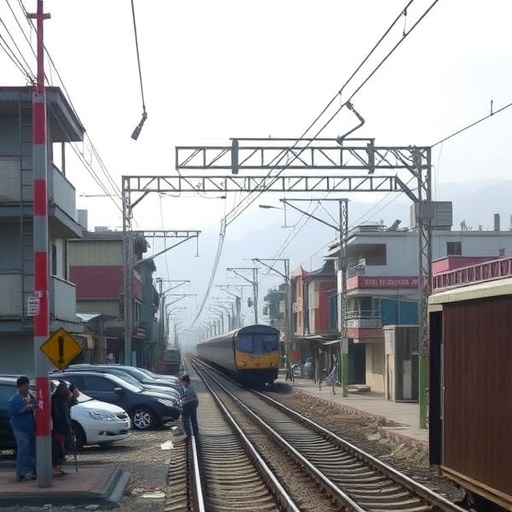In metropolitan areas across the globe, urban life is a cacophony of sounds that form a complex auditory tapestry. Among these sounds, the relentless thrum of railway traffic emerges as one of the most pervasive and disruptive forms of noise pollution. Recent research conducted by Jadon, Akhtar, and Mishra takes a closer look at the impact of railway noise exposure, particularly focusing on slum settlements within a metropolitan city. Their findings, detailed in the article published in Environmental Monitoring and Assessment, unveil a troubling picture of how vulnerable populations are affected by relentless noise pollution in their everyday lives.
The study was motivated by a pressing need to understand the nuances surrounding railway noise exposure, especially in densely populated urban landscapes where slum settlements often exist in proximity to major transport arteries. Here, the researchers employed a multi-faceted approach that combined extensive sound level measurements with socio-economic assessments of the communities affected. The results illuminate not only the intensity and frequency of railway noise but also its far-reaching consequences on health and well-being.
One of the primary goals of the study was to quantify the levels of railway noise that residents of slum areas are exposed to. To that end, the researchers strategically placed sound measurement devices at various locations across the city, capturing data during peak train operations. The devices recorded sound levels, which were then analyzed to understand the average noise exposure faced by individuals residing near railway lines. The findings were striking; many residents were subjected to noise levels far exceeding recommended limits, raising alarms about possible long-term health effects.
Beyond sheer sound levels, the research also delves into the psychological and social implications of living in such noisy environments. The authors discuss how chronic noise exposure can lead to increased stress levels, sleep disturbances, and a plethora of connected health issues such as cardiovascular disease and anxiety. This aspect of the study is particularly alarming as it unveils a silent health crisis manifesting in communities often already burdened by socioeconomic challenges. The research compellingly argues that noise pollution must be viewed through the lens of public health, given its substantial impact on quality of life.
The authors also highlight the role of urban planning and policy in mitigating railway noise pollution. The absence of sufficient buffer zones and sound barriers around railway lines exacerbates the problem, resulting in slum residents facing the dual challenges of inadequate housing and overwhelming noise. Recommendations put forth by the researchers include the need for improved urban planning regulations that prioritize the health and comfort of all city inhabitants—particularly those in vulnerable communities. Effective policy implementation could serve as a crucial step toward alleviating the burdens of noise pollution for these marginalized residents.
Additionally, the research raises critical questions about the recent advancements in noise reduction technologies in urban environments. The study suggests that there is an urgent need for cities to adopt innovative solutions such as advanced rail design, sound-absorbing materials, and community engagement in the planning process. By integrating these technologies into existing infrastructures, cities can take significant strides toward reducing the impact of railway noise on surrounding communities.
An intriguing aspect of the study is its focus on the intergenerational effects of noise pollution in slum settlements. According to the authors, the implications of chronic exposure to railway noise may extend beyond immediate health concerns, potentially affecting future generations as well. Children raised in these environments could experience developmental delays and cognitive impairments linked to noise exposure, leading to a cycle of disadvantage that is hard to break. This critical insight underscores the importance of addressing noise pollution as a long-term public health challenge that requires immediate attention.
The researchers also conducted targeted surveys among residents to gather qualitative data regarding their experiences with railway noise. Testimonials from community members reveal a shared sense of frustration and helplessness, with many feeling unheard by policymakers. This qualitative perspective enriches the study, prompting a call for more inclusive approaches that allow residents to voice their concerns and propose viable solutions.
Furthermore, the study paints a portrait of resilience amongst the residents of slum settlements. Despite the overwhelming challenges posed by railway noise, many community members demonstrate remarkable adaptability. This insight serves as a reminder of the human spirit’s capacity to endure through hardships, yet it also stresses the importance of providing tangible support to enable these communities to thrive amidst adversity.
In conclusion, the research undertaken by Jadon, Akhtar, and Mishra presents a comprehensive examination of the alarming effects of railway noise exposure on slum settlements in metropolitan cities. By illuminating the health implications, the need for proactive urban planning, and the importance of community involvement, this study lays the groundwork for informed discussions and actions aimed at mitigating the burdens of noise pollution. The findings serve as a clarion call for policymakers, urban planners, health professionals, and society at large to prioritize the well-being of vulnerable populations and foster environments where they can live without the relentless intrusion of railway noise.
Ultimately, as urban centers continue to expand, understanding the intersection of railway noise pollution and health equity will be essential for developing sustainable urban environments. By rallying around these findings and acknowledging the scope of the problem, we can advocate for systemic change that prioritizes health, well-being, and equality for all city dwellers.
Subject of Research: The impact of railway noise exposure on slum settlements in metropolitan areas.
Article Title: Assessment of railway noise exposure in slum settlements of a metropolitan city.
Article References:
Jadon, R.P.S., Akhtar, N. & Mishra, R.K. Assessment of railway noise exposure in slum settlements of a metropolitan city.
Environ Monit Assess 197, 1059 (2025). https://doi.org/10.1007/s10661-025-14483-8
Image Credits: AI Generated
DOI: 10.1007/s10661-025-14483-8
Keywords: railway noise, urban health, noise pollution, slum settlements, public health, urban planning, socioeconomic factors.




